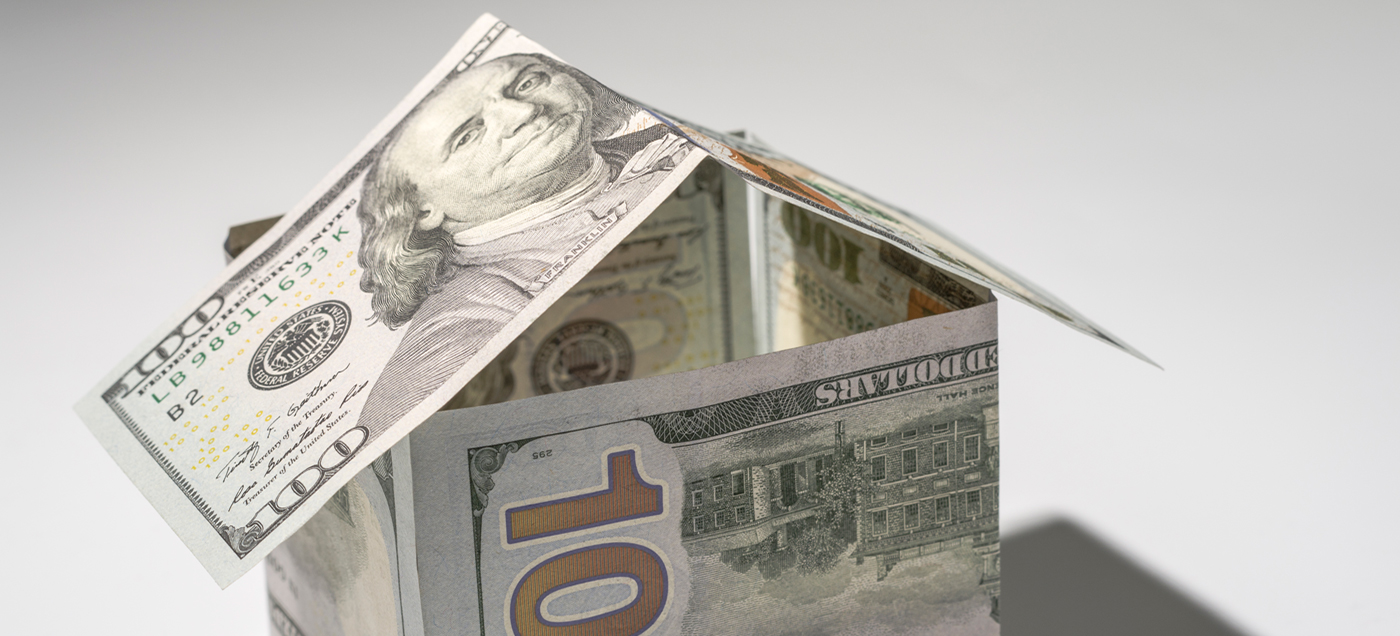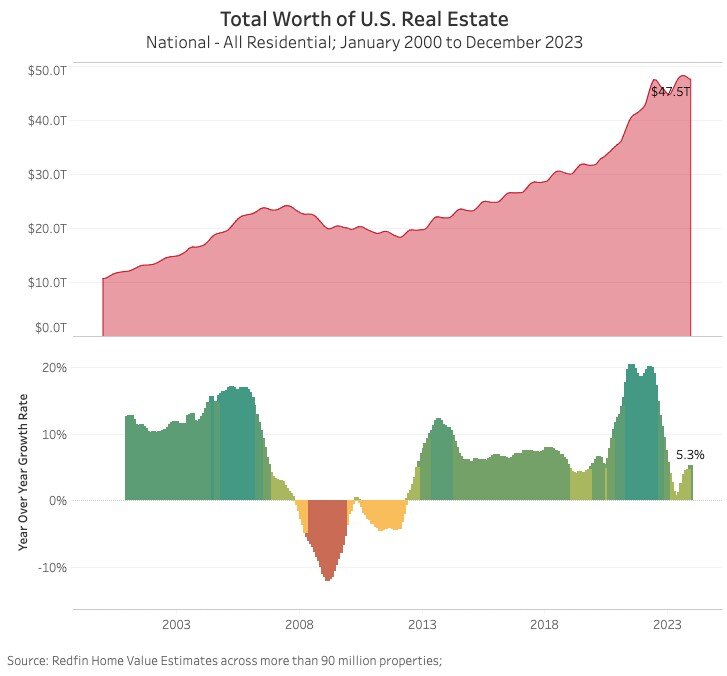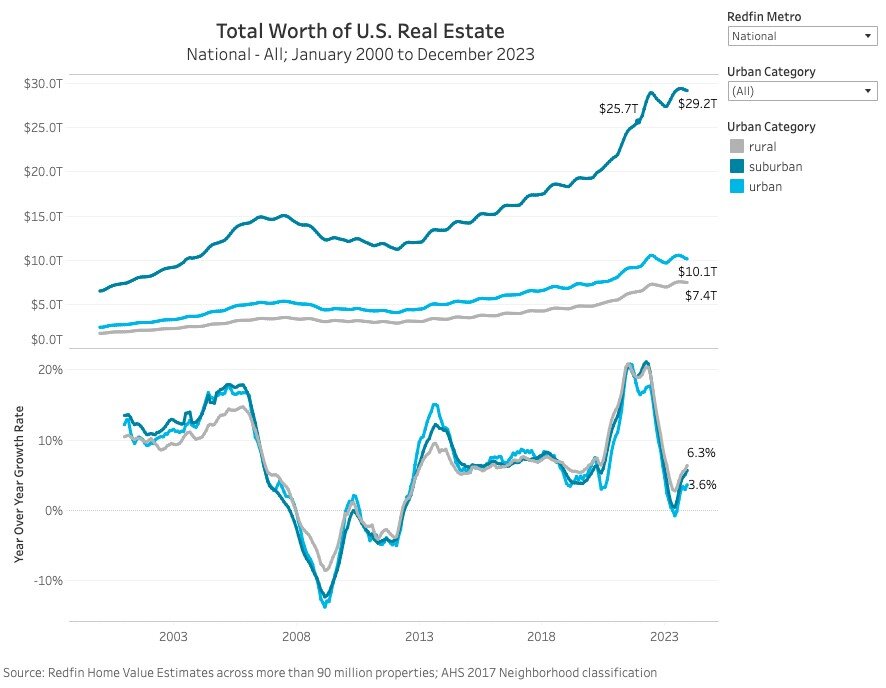Residential Real Estate News

$2 Trillion of U.S. Home Value Gains Enjoyed in 2023
Residential News » Seattle Edition | By Michael Gerrity | February 29, 2024 10:30 AM ET
Total value of U.S. homes jumped 5% in 2023 to $47.5 trillion
National property broker Redfin is reporting this week that the U.S. housing market gained $2.4 trillion over the last year, bringing its total value to $47.5 trillion. That's based on an analysis of the Redfin Estimate for more than 90 million U.S. residential properties as of December 2023.
In percentage terms, the total value of U.S. homes increased 5.3% from a year earlier in December 2023, the biggest increase in 11 months, and was up 13.3% ($5.6 trillion) from two years earlier.
Housing demand is sluggish due to elevated mortgage rates and affordability challenges, yet home values keep rising. There are three primary reasons:
- There's a shortage of homes for sale. Many homeowners are hesitant to put their houses on the market because they scored an ultra low mortgage rate in recent years, and selling would mean giving it up. Supply is even more constrained than demand, meaning buyers are competing for a limited pool of homes. That's propping up values for both homes that are already for sale and those that could hit the market in the future.
- Home values hit a low about a year ago. The total value of U.S. homes was nearing a trough at the end of 2022, which is part of the reason year-over-year growth at the end of 2023 was so large. It's typical for home values to cool in the winter, but they experienced an abnormally large slowdown in 2022 as the shock of surging mortgage rates sent a freeze through the housing market.
- More homes were built. While America is grappling with a housing shortage, it continues to build homes, which contributed to the gain in total home value last year.
"America's homeowners are sitting pretty. They're holding a massive amount of housing wealth, despite lackluster demand from buyers, because home values skyrocketed during the pandemic and now a supply shortage is preventing those values from falling," said Redfin Economics Research Lead Chen Zhao. "Prospective buyers aren't as lucky. The combination of elevated mortgage rates, high home prices and a limited pool of homes for sale means homeownership is about as unaffordable as ever. One bright spot for buyers is that mortgage rates should start declining before the end of 2024."
The average U.S. home was valued at $495,183 as of December, up from $474,740 a year earlier. The average home value jumped past $500,000 in both the summer of 2023 and the summer of 2022, meaning the typical homeowner who bought during those times has lost value.
Metros close to but more affordable than New York City post largest jumps in home value; Midwest also sees gains
The total value of homes in Newark, NJ rose 12.8% year over year to $359.6 billion in December--a larger gain than any other metro. Next come two other East Coast metros: New Haven, CT (11.9%) and Camden, NJ (10.8%). Ranking fourth is Charleston, SC (10.8%), followed by three Midwest metros: Elgin, IL (10.4%), Grand Rapids, MI (9.8%) and Milwaukee (9.7%).
Places like Newark and Camden are likely seeing home values jump in part because they're attracting demand from people who are priced out of New York and can now work remotely. Midwestern metros like Milwaukee and Grand Rapids are experiencing home value gains for a similar reason: They're affordable, and when mortgage rates and home prices are elevated, demand for affordable homes goes up.
Home values aren't holding up as well in pricey metros and pandemic boomtowns
Four metros saw declines in overall home value: Boise, ID (-3.8%), New York (-1%), New Orleans (-0.8%) and Stockton, CA (-0.7%). The metros with the smallest increases were Philadelphia (0.3%), Honolulu (0.8%), Austin, TX (1%), Denver (1.3%) and Riverside, CA (1.6%).
Most of the metros above have something in common: They've become unaffordable for many homebuyers, so home values no longer have much room, if any, to rise, because there's a cap on demand. New York, Honolulu, Riverside and Denver all have median home sale prices of at least $550,000--well above the national median of $402,343. And in Boise and Austin, which also have median sale prices above the national level, many people are priced out because an influx of out-of-towners caused home values to skyrocket during the pandemic.
Home values in urban areas aren't holding up as well as those in the suburbs, rural areas
The total value of homes in urban areas rose 3.6% year over year to $10.1 trillion in December. Meanwhile, the value of homes in the suburbs rose 5.6% to $29.2 trillion and the value of homes in rural areas increased 6.3% to $7.4 trillion.
The suburbs came back into vogue during the pandemic while cities fell out of favor--largely due to the shift to remote work and the housing affordability crisis. While cities have bounced back to some extent as employers have asked workers to return to the office, many Americans still work remotely, incentivizing homebuying and building in far-flung, affordable areas.
Suburban housing has a much higher total value than rural and urban housing simply because most Americans live in the suburbs. There are about 56 million residential properties in the suburbs, compared with just over 20 million each in rural and urban areas.
Sign Up Free | The WPJ Weekly Newsletter
Relevant real estate news.
Actionable market intelligence.
Right to your inbox every week.
Real Estate Listings Showcase
Related News Stories
Residential Real Estate Headlines
- U.S. New-Home Sales Surge in August as Mortgage Rates Ease
- Despite Increased Foreign Buyer Activity, Miami Residential Sales Dip 11 Percent in August
- California Home Sales Enjoy Modest Uptick as Mortgage Rates Ease
- U.S. Home-Flipping Profits Sink to Lowest Level Since 2008 Financial Crisis as Costs Climb
- Why the World's Rich Are Flocking to Europe in 2025
- Federal Reserve Delivers First Rate Cut of 2025 as Mortgage Relief Proves Limited
- Homebuilder Sentiment Holds Steady in U.S. as Rate-Cut Bets Lift Outlook
- U.S. Mortgage Rates Experience Sharpest Weekly Drop in Over a Year
- U.S. Foreclosures Rise for Sixth Straight Month as Affordability Pressures Mount
- Black U.S. Homeownership Rate Falls to Two-Year Low as Job Losses Mount
- Las Vegas Home Prices Flatten as Listings Surge, Sales Slow
- Cooling Miami Housing Market Sees 16 Percent Annual Sales Drop in July
- U.S. Mortgage Delinquencies Uptick in June Amid Regional Pressures
- California, Florida Top U.S. Housing Markets Most at Risk of Downturn
- 30-Year Mortgage Drops to 6.56 Percent in Late August, Lowest Since October 2024
- Investors Maintain Elevated Role in U.S. Housing Market Despite Slight Pullback
- Pending Home Sales Show Mixed Signals as U.S. Buyers Remain Cautious
- Canadian Home Sales Extend Recovery in July
- U.S. Home Sales Rise in July as Buyers Gain More Bargaining Power
- Zombie Foreclosures Edge Up Across U.S.
- 2.6 Million Homes at Wildfire Risk Across 14 Western States in 2025
- One in Five Americans Willing to Trade Personal Safety for Home Affordability
- U.S. Home Price Growth Slows as Affordability Pressures Mount in 2025
- U.S. Mortgage Rates Dip to Four Month Low in Early August
- U.S. Mortgage Applications Rise in Late July, Breaking Four-Week Slump
- Hong Kong's Housing Market Stuck in Stalemate as Bulls and Bears Face Off
- U.S. Condo Market Struggles in 2025
- U.S. Pending Home Sales Remain Sluggish in June
- Los Angeles Area Wildfires Destroyed Nearly $52 Billion in Homes Last January
- Greater Palm Beach Area Residential Sales Slip in June Amid Growing Inventory
- Economic Resilience Lifts U.S. Housing Outlook Going Forward
- New Home Sales Stagnate as Affordability Struggles Continue in America
- U.S. Housing Market Slips in June as Prices Hit New Highs
- Florida, California Continue to Reign Supreme as America's Ultraluxury Housing Markets
- Caribbean Housing Market Evolves into Global Second-Home Hotspot
- U.S. Home Sales See Highest June Cancellation Rate on Record
- Orlando Housing Market Cools in June as Listings Slide, Sales Slow
- Private Credit Surges in 2025 as Real Estate Developers Bypass Banks
- U.S. Condo Market Suffers Sharpest Price Drops in Over a Decade as Buyers Retreat
- Rising Taxes, Insurance Costs Undermine the Stability of U.S. Homeownership









